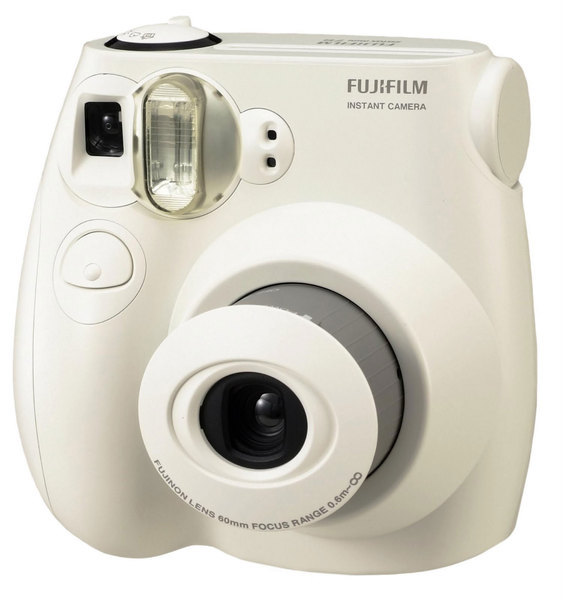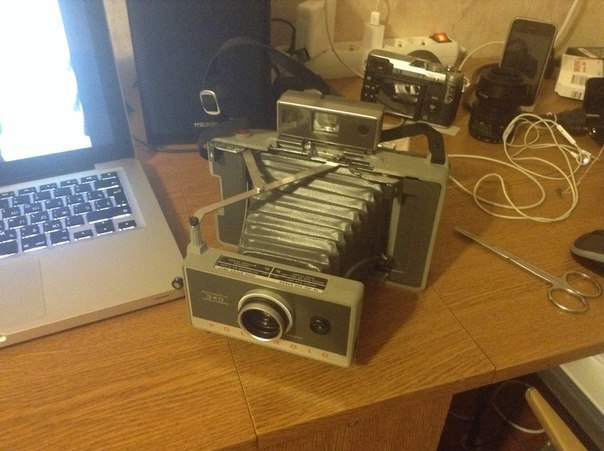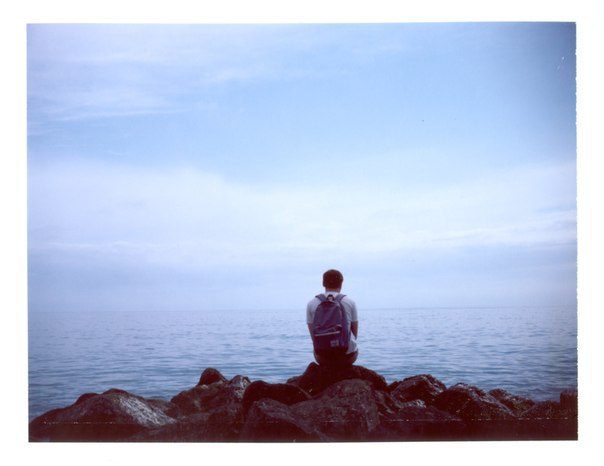Snapshot today or will Polaroid die?
Everyone remembers from childhood the wonderful square photos taken on the Polaroid 600. Sometimes the name of this company skips in the news. Is the Polaroid alive? Is there a snapshot today? Welcome to cat.

A bit of history. Inventor Edwin Land has done very important things for our life. In 1929, he developed the first polarizing material. But more importantly, he was able to apply his discovery in the everyday life of people. For example, the screen where you are looking now is largely due to the polarization effect. This effect has given the world many useful things. Edwin Land himself had 535 patents, which is not much less than Thomas Edison. And finally, you can recall that Edwin was the idol of Steve Jobs.
In 1948, Polaroid introduced the world to instant photo technology. Cameras and film improved every year and by the nineties reached its peak. Around these years, the Polaroids also invaded the Soviet Union, and even production of devices was launched under license from the Americans.
I remember these devices and for sure every house has at least one square frame with a white paper frame, and even signed in the right place. And the beauty of Polaroids was that they were easy to use. And the frames appeared immediately, there was no need to go to show the film and order successful frames.
But after the millennium, a "beautiful" figure appeared. Digital cameras are getting bigger, better and cheaper. Computers appeared at every home and photographs could no longer go to print, but stored directly on the hard drive. Film photography was dying along with instant photography; film makers were bankrupt before our eyes. And the development of social networks and even more so "killed" paper photos.
So in 2001, the company Polaroid began bankruptcy proceedings and eventually sold. And then it was sold again. From that moment on, the company made strange, unnecessary products, which I don’t even want to recall here.
In the meantime, there were always professionals who loved to film and, of course, Polaroid. They were joined simply by photography enthusiasts and similar hipsters. For such people in 2008, the Impossible Project arose, immediately after the termination of the production of instant films by Polaroid. They began to produce the very cartridges for "square" frames, the price, unfortunately, is still high.
At this time I was in my second year and always dreamed of finding an old Polaroid and breathing new life into it. But there was a big “BUT”, cassettes now cost 1200-1800 rubles per piece (in which there were only 8 frames, which is ~ 180 rubles per frame).
For a poor student, that was too much. Because dreams remained dreams and I continued to play the guitar actively. But by the 5th year, my desire to photograph won (and a little money appeared) and began to film, after a couple of years and digital, and finally in my measured life a new sip of instant photography appeared.
The fact is that the wonderful company Fujifilm already in 1990 began to produce its own instant photo cameras with new card formats. Namely, the size of a business card, and the double size of a business card. These were cameras called Fujifilm Instax and Wide. I bought myself the cheapest Fujifilm Instax 7s. I will not breed lyrics, although I really want to, but just say that the minimum price for a camera is 2600 rubles, and a cassette with 10 frames on all well-known Chinese sites can be bought for 300-400 rubles (which will be 30-40 rubles per frame). Of course, many will say that it is too expensive, but for me to spend 300 rubles a month for 10 instant shots that make me feel good does not seem like a waste of money. But this did not stop there and the awl in the same place did not stop pushing me further.


Once, while reading the Internet, I came across information that Fujifilm is releasing yet another cassette for instant photography, and they are called FP-100c, FP-3000b. It turned out that this is a form factor of the old Polaroid cameras, which were released in the distant 1970s, and the name of this series is Polaroid Land Camera. Googling and looking at these cameras, I fell in love. And I certainly wanted to get myself one, and of course, shoot it.
And then everything turned out to be simple. You can buy such a camera on ebay.com, but not the fact that it will work, but there are two good online stores. In the USA and Ireland, in the second I decided to order a camera. I wrote an e-mail with the seller, he answered all the questions and I made an order. At the same time, he ordered three cassettes for test shots on ebay.com. And of course, all this came without any problems, everything turned out to be working. A couple of videos on youtube.com helped - how to use these devices correctly and not to lose the shutter speed. If it will be interesting to you, I myself can shoot a video or devote a new article on Habré with tips, tricks and clear instructions for handling these rare cameras.
I purchased a Polaroid Land Camera 340 model, it has glass lenses (yes, there are plastic), a mechanical development timer, a plastic case (there are iron, but heavy). There are also different focusing systems, in my model it looks exactly the same as on the FED or old watering cans. It cost me this pleasure along with the delivery of ~ 4000 rubles. It is better to buy cassettes on ebay.com, there the prices are lower, I take small wholesale in 3-10 packs and one cassette for 10 frames costs 500 rubles. And this is 50 rubles per frame, quite a lot of money, because you should not forget that this is not a figure and you will not make hundreds of frames per minute. I have 5 thousand rubles = 100 frames is enough for six months to a year, quite adequate numbers, for my taste.

The frames made on this old Polaroid delight me to the core. They are large in size and can be easily scanned. Of course, the quality is comparable to a 5 megapixel camera, but that color, those emotions can never be conveyed by a figure.
Now I am increasingly taking this colossus with me and photographing friends, buildings, and the sea. The pleasure of the process and the result is beyond words. Sometimes such an aggregate creates genuine interest of others.



Answering the question asked in the title of the article, I want to express my vision. Polaroid is cool. It is a fact. The Polaroid firm is dead; what they are releasing now is shame and sadness. But instant photography will never die. There will always be amateurs and enthusiasts who love film photography, medium format and Polaroid. Here you can sing the praises of Fujifilm Corporation, which has revived instant photography in the modern world, and continues to support enthusiasts such as myself by releasing cassettes for old vehicles. I really hope that for my life it will be enough and these cassettes will not stop producing, and at least the Impossible Project will exist. Otherwise, the real kind “tube” snapshot will die under the onslaught of digital mini-printers with paint.
This article is the first for me. Hopefully take root in this thinking community. Good to all.

A bit of history. Inventor Edwin Land has done very important things for our life. In 1929, he developed the first polarizing material. But more importantly, he was able to apply his discovery in the everyday life of people. For example, the screen where you are looking now is largely due to the polarization effect. This effect has given the world many useful things. Edwin Land himself had 535 patents, which is not much less than Thomas Edison. And finally, you can recall that Edwin was the idol of Steve Jobs.
In 1948, Polaroid introduced the world to instant photo technology. Cameras and film improved every year and by the nineties reached its peak. Around these years, the Polaroids also invaded the Soviet Union, and even production of devices was launched under license from the Americans.
I remember these devices and for sure every house has at least one square frame with a white paper frame, and even signed in the right place. And the beauty of Polaroids was that they were easy to use. And the frames appeared immediately, there was no need to go to show the film and order successful frames.
But after the millennium, a "beautiful" figure appeared. Digital cameras are getting bigger, better and cheaper. Computers appeared at every home and photographs could no longer go to print, but stored directly on the hard drive. Film photography was dying along with instant photography; film makers were bankrupt before our eyes. And the development of social networks and even more so "killed" paper photos.
So in 2001, the company Polaroid began bankruptcy proceedings and eventually sold. And then it was sold again. From that moment on, the company made strange, unnecessary products, which I don’t even want to recall here.
In the meantime, there were always professionals who loved to film and, of course, Polaroid. They were joined simply by photography enthusiasts and similar hipsters. For such people in 2008, the Impossible Project arose, immediately after the termination of the production of instant films by Polaroid. They began to produce the very cartridges for "square" frames, the price, unfortunately, is still high.
At this time I was in my second year and always dreamed of finding an old Polaroid and breathing new life into it. But there was a big “BUT”, cassettes now cost 1200-1800 rubles per piece (in which there were only 8 frames, which is ~ 180 rubles per frame).
For a poor student, that was too much. Because dreams remained dreams and I continued to play the guitar actively. But by the 5th year, my desire to photograph won (and a little money appeared) and began to film, after a couple of years and digital, and finally in my measured life a new sip of instant photography appeared.
The fact is that the wonderful company Fujifilm already in 1990 began to produce its own instant photo cameras with new card formats. Namely, the size of a business card, and the double size of a business card. These were cameras called Fujifilm Instax and Wide. I bought myself the cheapest Fujifilm Instax 7s. I will not breed lyrics, although I really want to, but just say that the minimum price for a camera is 2600 rubles, and a cassette with 10 frames on all well-known Chinese sites can be bought for 300-400 rubles (which will be 30-40 rubles per frame). Of course, many will say that it is too expensive, but for me to spend 300 rubles a month for 10 instant shots that make me feel good does not seem like a waste of money. But this did not stop there and the awl in the same place did not stop pushing me further.


Once, while reading the Internet, I came across information that Fujifilm is releasing yet another cassette for instant photography, and they are called FP-100c, FP-3000b. It turned out that this is a form factor of the old Polaroid cameras, which were released in the distant 1970s, and the name of this series is Polaroid Land Camera. Googling and looking at these cameras, I fell in love. And I certainly wanted to get myself one, and of course, shoot it.
And then everything turned out to be simple. You can buy such a camera on ebay.com, but not the fact that it will work, but there are two good online stores. In the USA and Ireland, in the second I decided to order a camera. I wrote an e-mail with the seller, he answered all the questions and I made an order. At the same time, he ordered three cassettes for test shots on ebay.com. And of course, all this came without any problems, everything turned out to be working. A couple of videos on youtube.com helped - how to use these devices correctly and not to lose the shutter speed. If it will be interesting to you, I myself can shoot a video or devote a new article on Habré with tips, tricks and clear instructions for handling these rare cameras.
I purchased a Polaroid Land Camera 340 model, it has glass lenses (yes, there are plastic), a mechanical development timer, a plastic case (there are iron, but heavy). There are also different focusing systems, in my model it looks exactly the same as on the FED or old watering cans. It cost me this pleasure along with the delivery of ~ 4000 rubles. It is better to buy cassettes on ebay.com, there the prices are lower, I take small wholesale in 3-10 packs and one cassette for 10 frames costs 500 rubles. And this is 50 rubles per frame, quite a lot of money, because you should not forget that this is not a figure and you will not make hundreds of frames per minute. I have 5 thousand rubles = 100 frames is enough for six months to a year, quite adequate numbers, for my taste.

The frames made on this old Polaroid delight me to the core. They are large in size and can be easily scanned. Of course, the quality is comparable to a 5 megapixel camera, but that color, those emotions can never be conveyed by a figure.
Now I am increasingly taking this colossus with me and photographing friends, buildings, and the sea. The pleasure of the process and the result is beyond words. Sometimes such an aggregate creates genuine interest of others.



Answering the question asked in the title of the article, I want to express my vision. Polaroid is cool. It is a fact. The Polaroid firm is dead; what they are releasing now is shame and sadness. But instant photography will never die. There will always be amateurs and enthusiasts who love film photography, medium format and Polaroid. Here you can sing the praises of Fujifilm Corporation, which has revived instant photography in the modern world, and continues to support enthusiasts such as myself by releasing cassettes for old vehicles. I really hope that for my life it will be enough and these cassettes will not stop producing, and at least the Impossible Project will exist. Otherwise, the real kind “tube” snapshot will die under the onslaught of digital mini-printers with paint.
This article is the first for me. Hopefully take root in this thinking community. Good to all.
